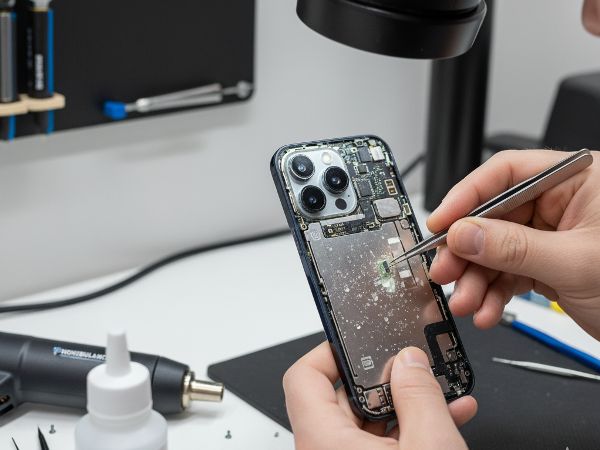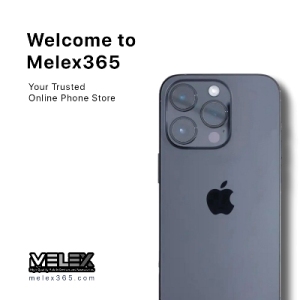It’s a feeling that drops your stomach to your feet. One second, your iPhone 13 is in your hand; the next, it’s sinking to the bottom of a pool. Here in Orange County, that “water” could be the ocean at Newport Beach, a backyard pool in Irvine, or even just a spilled drink at a cafe in Laguna Niguel.
The panic that sets in is real. Your photos, your contacts, your work—all seemingly gone.
Recently, a customer from right here in Orange County came into our shop, Phonebulance, with this exact problem. Their water damaged iPhone 13 was completely dead. It wouldn’t turn on, it wouldn’t charge, and it showed no signs of life. They thought it was a total loss.
But here’s the good news: “dead” doesn’t always mean gone.
In this case study, we’re going to pull back the curtain and show you the exact, step-by-step process our expert technicians used to bring this “dead” iPhone 13 back to life. We’ll show you what we found, how we fixed it, and (most importantly) how we recovered all the customer’s precious data.
Key Takeaways at a Glance
| Topic | Key Point |
| Immediate Actions | Do NOT plug it in. Do NOT put it in rice. Power it off immediately and bring it to a professional. |
| The “Rice Myth” | Rice is ineffective. It leaves behind starch and dust, which can mix with water to create a corrosive paste. |
| The Real Damage | It’s not the water itself, but the corrosion and short circuits that happen when electricity meets water on the logic board. |
| Our Repair Process | A successful repair involves a full teardown, ultrasonic cleaning of the logic board, and advanced microsoldering. |
| The Goal | The #1 goal is almost always data recovery. A working phone is a bonus, but saving your photos and files is the real win. |
The First 60 Minutes: What Not to Do With a Wet iPhone
Before we get to our case study, let’s address the panic-fueled mistakes we see every single day. What you do in the first hour after water exposure can mean the difference between a simple cleaning and a catastrophic, unrecoverable failure.
Why the Bag of Rice Is Your Enemy
We know, everyone says to do it. It’s the “common wisdom.” Unfortunately, it’s also completely wrong.
Putting a phone in rice is one of the worst things you can do.1
- It’s Not Effective: Rice can only absorb liquid it’s in direct contact with. It does absolutely nothing to pull thedeep-seated moisture and humidity from inside the complex layers of your iPhone.
- It’s Corrosive: The fine starch and dust from the rice grains get into the charging port, speaker holes, and (if the2seals are broken) the phone’s interior. This dust mixes with the water to create a gummy, conductive paste that
accelerates corrosion.
- It Gives False Hope: The biggest danger? You wait. You let your phone sit in a bag of rice for two or three days,believing you’re fixing it. In reality, you’re just giving corrosion a 48-hour head start to eat away at the delicate
connectors and components on the logic board.
In our experience, phones that come to us after a “rice bath” are often in worse condition than those that come in fresh
from the water.
Don’t Plug It In! (The #1 Mistake)
Your first instinct might be to see if it still works by plugging it in to charge. Never, ever do this.
Think of the logic board as a complex map of tiny electrical highways. Water acts like a bridge, connecting highways that should never touch. When you introduce power from the charger, you send a massive electrical current across these new, improper bridges.
This is called a short circuit. It’s how components get “fried,” and it is the single fastest way to turn a recoverable phone into a paperweight. Even if the phone is off, plugging it in activates charging circuits that can (and will) short out.
The correct steps are simple:
- Power it off. Do not press any buttons.
- Do not plug it in.
- Wipe it down with a towel.
- Bring it to a professional repair shop immediately. Time is your enemy.
Our Case Study: A “Dead” iPhone 13 from Irvine
Now, let’s get to the phone that was brought to our Laguna Niguel shop. A customer from Irvine had dropped their iPhone 13 in their pool. They dried it off, and it seemed to work for about an hour before it suddenly went black. It was completely dead.
Step 1: The Initial Assessment (The Customer’s Story)
The customer did the right thing: they didn’t try to charge it overnight. They brought it straight to us.
Our first step is always to listen. Pool water? Saltwater? Toilet water? Knowing the type of liquid is critical. Pool water (chlorine) and saltwater (salt) are far more corrosive than tap water.
Next, we opened the SIM tray. We were looking for one thing: the LCI (Liquid Contact Indicator). On a dry phone, this sticker is white or silver. On this iPhone 13, it was bright red. This confirmed liquid had breached the phone’s internal seals.
Step 2: The Professional Triage (Opening the Device)
This is where our professional experience comes in. You can’t fix what you can’t see.
We immediately performed a full teardown of the iPhone 13. This means carefully removing the screen, disconnecting the battery (the most critical step to stop all power), and removing every component: the camera system, the charging port, the Face ID array, and finally, the logic board.
The logic board is the “brain” of the iPhone.3 It’s where the CPU, the memory (your data), and all the critical control chips live.
Under the microscope, we could see the problem clearly. There was visible corrosion—a fuzzy, greenish-blue residue—on several parts of the logic board, especially around the power management (PMIC) and display circuits. The customer’s “dead” phone wasn’t dead; it was just shorted out.
Step 3: Identifying the Real Culprit – The Logic Board
Here’s a secret of the repair industry: most repair shops don’t fix logic boards. They just replace them. If you take a water damaged iPhone 13 to Apple, their only solution is to replace the entire device (or the entire logic board), which costs hundreds of dollars and results in 100% data loss.
Why? Because your data (photos, messages, etc.) is encrypted and tied specifically to your phone’s original logic board. If you replace the board, you lose the data.
Our goal at Phonebulance is different. We don’t just want to fix the phone; we want to save your memories. That means we have to repair the original board.
Beyond Parts-Swapping: The Art of Microsoldering
This is where true expertise is required. Fixing a water-damaged logic board is like performing microscopic surgery.
Cleaning the Corrosion: The Ultrasonic Bath
First, we can’t repair a dirty board. We placed the logic board into a special ultrasonic cleaner. This machine uses high-frequency sound waves and a special cleaning solution to vibrate at a microscopic level, safely blasting away all the corrosive residue and mineral deposits from under the tiny chips and components—places a brush could never reach.
After a 15-minute bath and a thorough drying process, the board looked brand new. But the damage was already done. The corrosion had eaten away at several tiny pathways.
Diagnosing the Short: Finding the Failed Components
This is where our technicians’ expertise shines. Using a multimeter and the official iPhone 13 board schematics (the “blueprint” of the logic board), we began “testing” the circuits.
We quickly found a “short to ground” on a main power line. In simple terms, a power line that was supposed to feed a vital chip was instead dumping all its electricity directly into the “ground,” or the board’s negative plane. This is a dead short, and it’s why the phone wouldn’t turn on. The phone was protecting itself by refusing to boot.
We traced the short to a tiny component called a capacitor. It was a component responsible for filtering power to the display circuit. It had been destroyed by the corrosion and was now acting as a broken gate, diverting all the power.
The Delicate Surgery: Replacing Damaged Capacitors
The component that failed was smaller than a grain of sand.
Using a high-powered microscope, a precision micro-soldering iron (which can reach over 800°F at its tiny tip), and a steady hand, our technician did the following:
- Isolated the Area: Protected the nearby CPU and memory chips with heat-resistant tape.
- Removed the Bad Part: Used a hot air tool to gently heat and remove the tiny, fried capacitor.
- Cleaned the Pads: Cleaned the microscopic contact points (pads) on the logic board where the new component would sit.
- Replaced the Part: Carefully micro-soldered a new, identical capacitor (taken from a donor board) into its exact place.
We found two other capacitors and one resistor in a similar “shorted” state. We repeated this delicate process for all of them. This is the “microsoldering” that sets component-level repair shops apart.
The Moment of Truth: Booting Up and Data Recovery
After the board-level repairs were complete, we re-assembled the phone with a test screen and a new battery (the original was compromised and unsafe).
We connected our diagnostic tool and… success. The familiar Apple logo appeared on the screen. The phone booted up.
We navigated to the photo gallery, and there they were: thousands of photos and videos. The customer’s contacts, messages, and notes were all intact. We had successfully repaired the logic board and, in doing so, saved all their data.
Why Water Damage Repair is Really About Data
In the end, we replaced the phone’s screen (which had also been damaged by the water) and the battery. The phone was 100% functional. But the customer wasn’t paying for a “fixed phone.” They were paying for the data. The phone itself is replaceable; the photos of their family, the last text messages from a loved one, and the important work documents were not.
This is the core of our philosophy. We don’t just fix hardware; we rescue your digital life.
Isn’t the iPhone 13 Waterproof? Understanding IP Ratings
This is a question we get all the time. “How did this happen? My iPhone 13 has an IP68 rating!”
It’s a great question. “IP68” means the phone is rated to survive in up to 6 meters of fresh water for 30 minutes.7 But there are three crucial catches:
- Lab Conditions vs. Real World: That rating is achieved in a controlled lab with still, pure water.8 It does not applyto chlorinated pool water, corrosive saltwater, or other liquids like soap, beer, or coffee.
- Seals Degrade: The rubber and adhesive seals that give the iPhone its water resistance are not permanent.9 Theydegrade over time from heat (like being left in a car in the Orange County sun), physical drops, and
age. A phone that’s two years old has significantly weaker seals than a new one.
- Warranty Exclusion: The most important part? Apple’s own warranty does not cover liquid damage. They know the rating isn’t a guarantee, which is why they put LCIs (Liquid Contact Indicators) in the phone.
Your iPhone’s water resistance is a safety net for an accidental splash, not a license to go swimming with it.
Why Choose a Local Orange County Repair Specialist?
When you’re dealing with a water damaged iPhone 13, you have a few options.
- You could go to Apple, who will tell you the data is lost and offer you an expensive replacement device.
- You could mail your phone to a faceless online data recovery center and wait weeks for an update.
- Or, you can come to a local expert.
As an Orange County-based repair shop, we live and work in your community. When you come into Phonebulance in Laguna Niguel, you’re not talking to a salesperson; you’re talking directly to the technicians who will be working on your device. We can show you the corrosion under the microscope, explain the process in person, and give you a real-time assessment.
We have the advanced microsoldering tools and the expert-level experience to perform the delicate “board-level surgery” that most shops (including Apple) simply won’t.
Your Data Isn’t Lost Until We Say It Is
This iPhone 13 case study had a happy ending. A “dead” phone, written off as a total loss, was fully repaired, and 100% of the customer’s data was saved.
It’s a powerful reminder: don’t believe the rice myth, and don’t give up hope. If you act fast and get your phone to a specialist who can treat the real problem (logic board corrosion), your chances of a full data recovery are surprisingly high.
If you have a water-damaged iPhone, iPad, or laptop in Orange County, don’t wait for the corrosion to set in.
Call Phonebulance in Laguna Niguel today for a free diagnostic. Let our experts be your device’s first responders.
Frequently Asked Questions
1. How much does it cost to repair a water damaged iPhone 13?
This is the most common question, and the answer is “it depends.” The cost is directly related to the extent of the damage.10 A simple ultrasonic cleaning might be relatively inexpensive, while a complex logic board repair with multiple component replacements will cost more. We offer a free diagnostic where we will open the device, assess the damage, and provide you with a no-obligation quote before any work begins.
2. Is my data (photos, contacts) lost forever?
Not usually! As this case study shows, data is stored on memory chips on the logic board. As long as the logic board can be repaired (even if the screen or battery can’t), the data can almost always be saved. The only time data is truly unrecoverable is if the memory chip itself is physically cracked or severely shorted, which is rare.
3. How long does a water damage repair take?
Time is critical, but the repair itself is not instant. A proper water damage service involves multiple steps: full teardown, a 15-30 minute ultrasonic cleaning, a 1-2 hour drying process, and then the microscopic diagnosis and repair, which can take several hours. We typically ask for 24-48 hours to do the job right. Rushing the process is how repairs fail later.
4. What if you can’t fix my phone or recover the data?
Our policy is simple: if we can’t recover your data, you don’t pay for the data recovery attempt. We believe in our skills, but we also believe in fair, risk-free service for our customers.
5. My phone fell in the ocean. Is that worse than a pool?
Yes, significantly. Saltwater is extremely conductive and incredibly corrosive.11 It’s the worst-case scenario for electronics. The salt residue crystallizes and aggressively eats away at solder joints and components. If your phone ever falls in the ocean, your window for a successful repair is much shorter. You need to get it to a professional immediately.

Phonebulance is your one-stop center!
Want to get the most out of your iPhone? At Phonebulance, we’re your one-stop center for all things smartphone! Whether you’ve cracked your screen, dropped it in water, or it’s simply acting sluggish, our certified technicians can diagnose and fix a wide range of issues. Contact us today or make an online appointment to learn more about our services and keep your smartphone connected and functioning like new!
Here is the list of our smartphone repair services:
- Apple iPhone
- Apple Watch
- Apple iPad
- Apple iPod
- Samsung Galaxy S Series
- Samsung Galaxy Note Series Samsung Galaxy Tab
- Google Pixel and Nexus
- OnePlus
- Other brands (LG, Motorola, HTC, Blackberry…)
Here is the list of our repair and fixing prices:
- iPhone LCD Screen Replacement
- iPhone Charging Port Replacement
- iPhone Battery Replacement (High Capacity)
- iPad screen replacement
- iPhone Back Camera Lens Replacement
- iPhone Rear Camera Repair
- iPhone Back Glass Repair Cost
Service Areas in Orange County South:



0 Comments